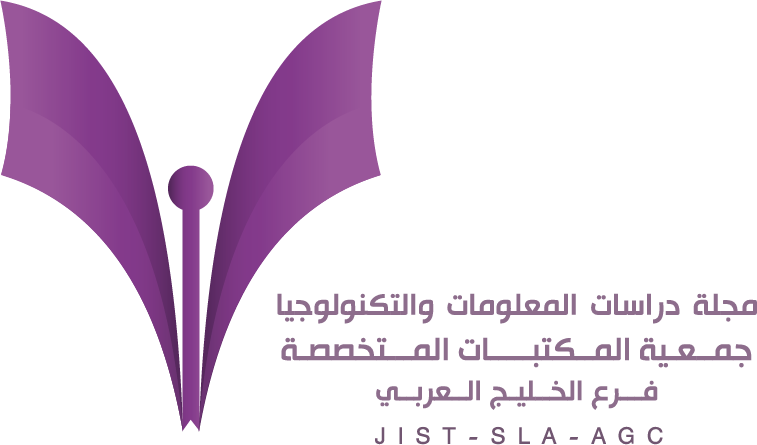-
oa مدى فعالية استخدام روبوتات المحادثة التوليدية Chatbot في تعزيز مشاركة المعرفة لدى أفراد المجتمع السعودي
- Source: Journal of Information Studies & Technology (JIS&T), Volume 2024, Issue 1, Mar 2024, 2
-
- 02 November 2023
- 13 December 2023
- 31 March 2024
Abstract
الملخص
هدفت هذه الدراسة إلى التعرف على مدى استخدام روبوتات المحادثة التوليدية Chatbot في تعزيز مشاركة المعرفة لدى أفراد المجتمع السعودي، وكذلك التعرف على مميزات ومعوقات استخدام روبوتات المحادثة التوليدية Chatbot في تعزيز مشاركة المعرفة لدى أفراد المجتمع السعودي، وأيضاً الكشف عن كيفية تعزيز مشاركة المعرفة باستخدام هذه الروبوتات لدى أفراد المجتمع السعودي، ولتحقيق أهداف هذه الدراسة استخدمت المنهج الوصفي المسحي من خلال استبانة وُزِّعت على عينة عشوائية بسيطة مكونة من 408 أفراد من أفراد المجتمع السعودي في مدينة الرياض من الفئة العمرية 20 سنة فما فوق. وتوصلت الدراسة إلى مجموعة من النتائج من أهمها: أن ChatGPT يعد أكثر نوع مستخدم بين أفراد العينة وبنسبة 88%. وأن مجال التعليم أكثر المجالات استخداماً لروبوتات المحادثة التوليدية Chatbot وذلك بنسبة 49%. وأما الغرض من استخدام روبوتات المحادثة التوليدية Chatbot فقد جاء أولاً البحث العلمي وبنسبة 59.3%، ويليه اكتساب المعرفة وبنسبة 16.7%. كما أوضحت النتائج نوع النماذج التوليدية المستخدمة في Chatbot فقد كانت غالبيتها لإنشاء النصوص، وذلك بنسبة 80.6%، وكشفت عن اتفاق آراء عينة الدراسة حول مميزات استخدام روبوتات المحادثة التوليدية Chatbot في تعزيز مشاركة المعرفة لدى أفراد المجتمع السعودي وبنسبة 82.6%، في حين كانت أعلى فقرة في البعد (توفير الوقت والجهد) وبنسبة 91.37%، ومن ثم يليها فقرة (تقدم إجابات فورية) وبنسبة 89.75%. وأيضاً أظهرت النتائج اتفاق عينة الدراسة حول معوقات استخدام روبوتات المحادثة التوليدية Chatbot في تعزيز مشاركة المعرفة لدى أفراد المجتمع السعودي بنسبة 82.8%، وكانت أهم فقراته (قلة البرامج والوسائل التي تدعم استخدام تقنية Chatbot في اللغة العربية) وبنسبة %85.2، ويليها (عدم وجود الخبرة الكافية لدى الفرد بسبب قلة الدورات المعطاة في مجال تقنية Chatbot) وبنسبة 84.41%. وأخيراً كشفت عن اتفاق عينة الدراسة حول تعزيز مشاركة المعرفة باستخدام تقنية Chatbot لدى أفراد المجتمع السعودي بما يمثل نسبة 86.18%، حيث كانت أعلى فقراته (تطوير برامج ووسائل تدعم استخدام تقنية Chatbot في اللغة العربية) وبنسبة 87.79%، ويليها (تقديم ورش عمل عن كيفية تعزيز مشاركة المعرفة باستخدام تقنية Chatbot) وبنسبة 87.69%. وتشمل التوصيات الرئيسية ضرورة تزويد أفراد المجتمع السعودي بمراجع متعددة اللغات وإرشادات تشرح آلية تقنية Chatbot، وتنظيم ورش عمل حول كيفية تعزيز مشاركة المعرفة باستخدام تقنية Chatbot، ودمج تقنيات Chatbot ومشاركة المعرفة في المناهج التعليمية.
This study aimed to assess the extent to which the Saudi society members (SSMs) utilize generative chatbots to enhance knowledge sharing, recognize the advantages and obstacles associated with their usage to enhance knowledge sharing among SSMs, and reveal how to enhance knowledge sharing within the Saudi community. To achieve the objectives of this study, a adopted the descriptive survey approach was employed using a questionnaire distributed to a simple random sample consisting of 408 SSMs aged 20 and above in Riyadh. The study revealed a set of results, highlighting ChatGPT as the most used ChatGPT (88%), and showed the most important domain for the use of Chatbots is education (49%). Using chatbots for scientific research purposes came first (59.3%), followed by the acquisition of knowledge (16.7%). Results also showed that the major type of generative models used in Chatbot was for creating texts (80.6%). Respondents agreed on the advantages of using generative chatbots in enhancing knowledge sharing among SSMs (agreement rate of 82.6%), The highest rate was observed in the item “saving time and effort” (91.37%), followed by “provides instant answers” (89.75%). On the other side, (82.8%) of the participants acknowledged obstacles to using generative chatbots in enhancing knowledge sharing among SSMs, with “shortage of programs and tools that support the use of Chatbot technology in Arabic” as the major challenge (85.2%), followed by “individual insufficient experience due to the lack of courses given in the field of Chatbot technology” (84.41%). Finally, the results revealed an agreement by the majority of the sample participants (86.18%) on enhancing knowledge sharing via the use of the generative Chatbot among SSMs, where “developing programs and tools that support the use of Chatbot technology in Arabic” received (87.79%), followed by “providing workshops on how to enhance knowledge sharing using Chatbot technology” (87.69%). The key recommendations include the necessity of providing SSMs with multilingual references and guidelines explaining the mechanism of Chatbot technology, organizing workshops on how to enhance knowledge sharing using Chatbot technology, incorporating Chatbot technologies and knowledge sharing into educational curricula.


